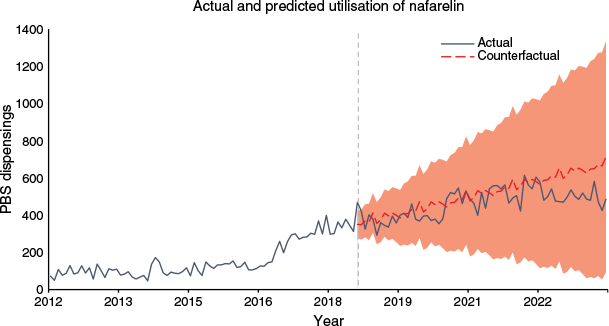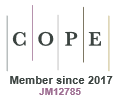Trends in endometriosis interventions: an interrupted time series analysis following the Australian National Action Plan for Endometriosis (NAPE) 2018
Chiemeka C. Chinaka A , Brenda Gannon A * and Jenny Doust B C
A , Brenda Gannon A * and Jenny Doust B C
A
B
C
Abstract
This study aimed to highlight trends in the utilisation of selected endometriosis treatments before and after the launch of the National Action Plan for Endometriosis and observe the impact of the action plan on the utilisation of these interventions.
Monthly Medicare and Pharmaceutical Benefits Scheme claims were used to represent the utilisation of laparoscopic resection and nafarelin for endometriosis. Time series analysis using autoregressive integrated moving average models was used to establish the trend in the utilisation of these treatments. An interruption was then applied at the launch of the plan, and a counterfactual prediction was modelled based on the claims made before the interruption. Factual values and counterfactual predictions were compared to evaluate the impact of the plan.
The action plan was associated with an immediate increase of 3.94 Medicare Benefits Schedule claims per month (95% CI −44.61 to 52.50) and an estimated change in slope of 1.30 claims per month (95% confidence interval (CI) −3.80 to 6.30) for laparoscopic resection. Nafarelin dispensing after the launch of the action plan had an immediate increase of 68.30 dispensing claims per month (95% CI −4.34 to 141.03), with a slope change of −2.84 claims per month (95% CI −10.975 to 5.293).
The results suggest that although the action plan was linked with a marked immediate spike in the utilisation of nafarelin, it did not make any difference in the long term. However, it may have contributed to a small but steady increase in the utilisation of laparoscopic resection, used in severe cases of the condition.
Keywords: chronic diseases, endometriosis, healthcare utilisation, health policy, interrupted time series, Medicare data, reproductive health.
Introduction
Endometriosis is a chronic, inflammatory disease that develops when tissue similar to the internal lining of the uterus (womb) grows outside the uterine cavity.1 Although the cellular origin of endometriosis is largely unknown, it is an oestrogen-dependent disease that affects 5–10% of women.2 An Australian longitudinal study identified that 6% of women had clinically confirmed endometriosis and another 5% had a clinically suspected case of the disease, where they may be waiting for surgical confirmation or elected not to have the surgical laparoscopy to confirm.3
Endometriosis has been associated with pelvic pain and subfertility.2,4 The symptoms are non-specific or the woman can even be asymptomatic, leading to misdiagnosis or being undiagnosed, especially since a confirmed diagnosis generally requires invasive laparoscopic visualisation of implants.5 To date, there is no curative therapy for endometriosis. Treatments are focused on alleviating the effect of the symptoms and improving overall health-related quality of life.5 The symptoms linked to endometriosis have been shown to affect patient’s physical, mental and social well-being, as well as incur a significant financial and economic burden on the patients, their families, the health system and society.5
Through its impact on healthcare costs and the productivity of patients and their families, it is estimated to lead to a cost of illness of between A$16,970 to A$20,898 per woman diagnosed per year and a total economic burden of A$6.5 billion per year.6 Due to this burden of disease and the increased call for action towards it and its associated symptoms, the Australian Government implemented a 5-year comprehensive preventive strategy known as the National Action Plan for Endometriosis (NAPE) in 2018.7 The priority areas of the action plan were to address the lack of education and awareness, improve clinical management and care and support research towards better outcomes for those involved.7 The plan was aimed at significant improvements in earlier diagnosis and broader treatment options involving a multi-disciplinary approach with clear management pathways for those with endometriosis.7
With the advancement of the 2018 action plan, it is crucial to evaluate what changes it has brought in addressing the substantial health burden of endometriosis to guide policymakers in planning for the future of those suffering from this chronic condition. We seek to answer the research question: ‘What was the impact of the National Action Plan for Endometriosis on the utilisation of selected medical treatments for endometriosis in Australia?’. To that effect, this article highlights the trends in the utilisation of two medical treatments for endometriosis before and after the launch of the action plan and observes immediate and lagged changes to the utilisation of these treatments, using interrupted time series (ITS) analysis.
Methods
Data
Endometriosis management usually begins with non-steroidal anti-inflammatory drugs and simple analgesics for pain relief, progressing through hormonal therapies such as combined oral contraceptives, continuous progestogens and, when needed, gonadotropin-releasing hormone (GnRH) analogues. In refractory cases, specialist options such as aromatase inhibitors or surgery alongside multidisciplinary support such as physiotherapy, psychological care and lifestyle modification are recommended.8 Importantly, the bulk of these treatments are also widely prescribed for many other conditions, from contraception and menopausal symptom control to chronic pain syndromes and hormone‑dependent disorders. This lack of condition-specificity makes it difficult to study the impact of public health interventions using national aggregate claims data. To improve on condition-specificity in our analysis, we focus on two medical treatments – laparoscopic resection of severe endometriosis (LRE), with Medicare Benefits Schedule (MBS) item number 35641, and nafarelin nasal spray with Pharmaceutical Benefits Schedule (PBS) item numbers 2962X and 5815C. LRE is only used in the management of endometriosis, hence observed changes in utilisation can be attributed to endometriosis-related interventions. Nafarelin, on the other hand, is a GnRH agonist used to manage mild to moderate symptoms such as pelvic pain and irregular menstruation in endometriosis, but is also employed in the treatment of central precocious puberty and in vitro fertilisation. Given that endometriosis can affect up to 10% of women of reproductive age, while central precocious puberty is relatively rare with an incidence of 14.6 per 10,000,9 it is plausible to assume that a substantial majority of nafarelin prescriptions are used for the treatment of endometriosis. Therefore, we can draw some inferences from the observed utilisation of naferelin pre- and post-NAPE. Common GnRH agonists such as goserelin are used for a wider range of indications, including breast cancer, prostate cancer, uterine fibroids, assisted reproduction and other conditions, so are not included in this analysis.
In this study, we utilise the monthly MBS and PBS item reports to observe trends in LRE and nafarelin. The monthly MBS claims of LRE and medication dispensing claims of naferelin were extracted from Services Australia, MBS item reports (for medical devices) and PBS item statistics (for pharmaceuticals) (medicarestatistics.humanservices.gov.au/statistics/mbs_item.html, accessed 25 August 2024). Importantly, this dataset only covers claims made within the private setting, since procedures performed in public hospitals are not included in the MBS data. This limits the inference that can be made from this analysis on the impact of NAPE on treatment utilisation, however, given the predominance of private-sector care for endometriosis, this study remains broadly insightful for national trends.
Interrupted time series
To estimate the impact of the action plan on the utilisation of treatments used for the management of endometriosis in Australia, we apply a time series analysis interrupted at the time of the release of the action plan in August 2018. We use the time series of the utilisation of the endometriosis treatment to establish the trend and then introduce the interruption at the end of July 2018. Following this, a hypothetical scenario where the NAPE plan was not introduced is modelled and is referred to as the counterfactual.10 The counterfactual scenario is compared to the actual observed series to analyse the impact of the interruption on the chosen outcome (treatment utilisation).11,12
An ITS can be modelled as follows.
where Ht is the outcome at time t, T is the time since the beginning of the series and Xt is a dummy variable that indicates the periods before and after the intervention, and εt is the error term. β0 represents the baseline level at time T, β1 is the change in the outcome associated with a time unit increase, β2 is the level change due to the intervention and β3 represents the change of the slope after the intervention, which uses the interaction between time and the intervention (TXt).
We used an autoregressive moving average (ARIMA) model to conduct the ITS analysis of the action plan for endometriosis interventions. An ARIMA model combines the characteristics of an autoregressive (AR), moving average (MA) model, with an integration (I) component.13,14 The AR process of the model refers to the fact that the current outputs are dependent on the past values, the MA part describes that current output as a function of the past error terms whereas the I component of the model handles non-stationarity by calculating the difference between adjacent observations to transform the series into a stationary series if required. Stationarity means that the mean and variance of the series do not fluctuate over time, allowing for meaningful predictions.13,14
Typically, the components of the ARIMA model are described by the notations p, d and q, representing the order of the AR, I and MA processes, respectively. Specifically, we employed an automatic algorithm from the forecast package in R to select the optimal ARIMA model for our time series data.15 The model selection process considered both seasonal and non-seasonal components, with a maximum of one order of differencing (non-seasonal (d) and seasonal (D)). We postulated potential sudden change followed by a gradual change in the slope of utilisation, which was modelled using a step and ramp function. The step would represent any sudden change immediately after the launch of the plan, whereas the ramp function was included as a variable that increases linearly over time to model a gradual change in slope that may be attributed to the action plan. An exhaustive search method was used to iteratively explore all possible model combinations and select the one with the lowest Akaike Information Criterion (AIC) or Baysian Information Criterion (BIC). Similar models have been applied in the evaluation of public health intervention through the analysis of national health insurance claims data.16
Ethics
Ethics approval was not required for this study as it exclusively utilised publicly available, aggregated data from the MBS and PBS, accessed via the Australian Government Department of Human Services website (https://medicarestatistics.humanservices.gov.au/statistics/mbs_item.html). No identifiable or individual-level data were used; only aggregated data were used.
Results
In this section, we show the impact of a national action plan on the utilisation of specific treatments for the management of endometriosis using Australian monthly Medicare claims for LRE and medicine dispensing claims for nafarelin. The primary outcome was the number of monthly claims for both treatments for which we had 144 months of observation, from January 2012 to December 2023. The time series diagrams in Figs 1 and 2 show increasing trends for both interventions, however, that of nafarelin had a flat trend before October 2016 when a policy that reduced the restrictions on the use of treatment was implemented (red vertical line in Fig. 2).17 This resulted in increasing access to nafarelin within specific disease indications as observed in the sharp increase in the dispensing claims from the end of 2016. Furthermore, we observe a clear seasonality in the utilisation of LRE with a consistent pattern of peaks and troughs even as the series trends upwards (Fig. 1). For nafarelin, however, no clear pattern of seasonality was observed.
Time series of the monthly claims for laparoscopic resection from 2012 to 2023. Note: the vertical grey dashed line represents the launch of the National Action Plan for Endometriosis in 2018.
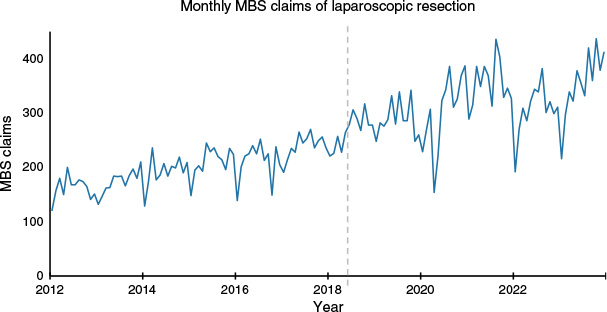
Time series of the monthly dispensing claims of naferelin nasal spray from 2012 to 2023. Note: the grey vertical line represents the launch of the National Action Plan for Endometriosis, while the red vertical dashed line represents a policy change in the use of nafarelin before the action plan.
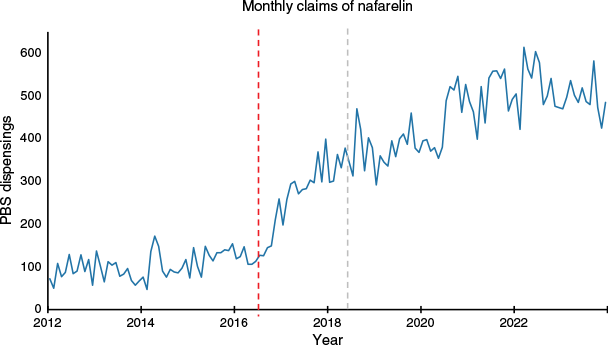
Due to the increasing trends observed before the launch of the action plan and the seasonality of the series, we induced stationarity by specifying a first-order difference (d = 1) to handle the increasing trend and a seasonal difference (D = 1) due to the presence of seasonality, and applied a periodicity of 12, indicating monthly data. After the iterative model selection process, the models with the least information criteria were ARIMA (0,1,1) (2,0,0)12 for LRE and ARIMA (2,1,0) (0,1,1)12 for nafarelin. This means that the non-seasonal part of the best model for LRE had no autoregressive term, one order of differencing to make the series stationary and one order of moving average. The seasonal component of the LRE model had a seasonal autocorrelation order of two, and no seasonal differencing or moving average terms. Similarly, the non-seasonal component of the nafarelin model had two autoregressive terms, one order of differencing and no moving average term, whereas the seasonal component had no autoregressive term, one order of differencing and a moving average order of one.
Although an automatic algorithm was used to select the models that minimised the information criteria, we checked the residuals for autocorrelation and normality and tested for white noise with the Box–Ljung test. The residual plots in the Supplementary material (Figs S1 and S2) of the autocorrelation function showed some sign of autocorrelation, but the residuals were normally distributed, and the white noise tests were not significant, indicating that the models selected provided the best fit among the models considered, while balancing complexity and accuracy.
Following the launch of NAPE, there was a step change of 3.94 MBS claims per month (95% confidence interval (CI) −44.61 to 52.50) and an estimated change in slope of 1.30 claims per month (95% CI −3.80 to 6.30) for the LRE procedure. As shown in Fig. 3, the predicted values of the MBS claims made for LRE in the scenario where the action plan was not implemented (red line) are compared with the actual values (blue line). It shows that the predicted counterfactual is lower than the actual values, suggesting that the action plan is associated with a slight immediate increase in the number of LRE procedures, followed by a gradual upward trend.
The observed (blue) and predicted (red dashed) MBS claims of laparoscopic resection for severe endometriosis. Note: the vertical dashed grey line shows the launch of the National Action Plan for Endometriosis. The light red shaded area depicts the confidence interval of the counterfactual.
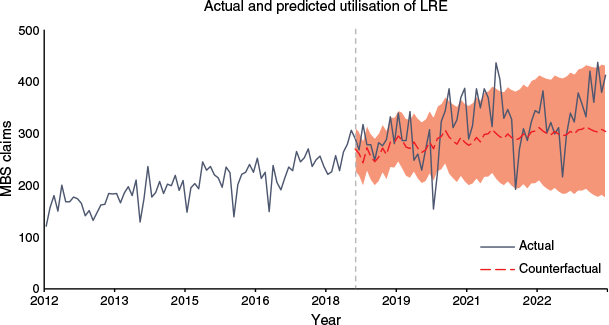
In contrast, nafarelin dispensing experienced an immediate change of 68.30 dispensing claims (95% CI −4.34 to 141.03), with a slope change of −2.84 claims per month (95% CI −10.975 to 5.293). Although there were significantly more claims immediately post-NAPE, the counterfactual model predicts that nafarelin use would have continued trending upwards anyway even without the plan (Fig. 4). However, there was a deviation between the factual and counterfactual trends from mid-2022, where there was significantly less nafarelin utilised than the ARIMA model predicted.
Discussion
The results provide valuable insights into the utilisation trends of two biomedical treatments LRE and nafarelin before and after the action plan (NAPE). By comparing actual claims data with counterfactual predictions, we assessed whether observable changes occurred following its implementation. Our findings indicate that following the launch of the plan, there was a step change of 3.94 MBS claims (95% CI −44.61 to 52.50) and an estimated change in slope of 1.30 claims per month (95% CI −3.80 to 6.30) for LRE. Essentially, in the first month after the plan, there were about four more claims in the actual series than the counterfactual forecast and a monthly upward drift by an additional claim each month relative to the pre-intervention trend. These results suggest that the action plan may have contributed to a modest increase in the utilisation of the procedure, but a wide confidence interval indicates uncertainty in the magnitude and direction of this effect.
Nafarelin dispensing experienced a considerable step change of 68.30 claims (95% CI −4.34 to 141.03), with a subsequent slope change of −2.84 claims per month (95% CI −10.975 to 5.293). While the post-NAPE period showed an immediate rise in claims, the counterfactual model suggests that nafarelin use would have continued on the same trend without the intervention. Interestingly, from mid-2022 onward, the actual utilisation of nafarelin fell below the counterfactual predictions, reflecting the negative slope (−2.84) in utilisation following the action plan. The reason for this is unclear but barriers to treatment including lack of access, stigma and disappointment with medical professionals persist within this population in Australia.18
While the action plan has unlocked several pathways for improved access, its full impact is tempered by infrastructure and workforce constraints, leading to long wait times for diagnostic and therapeutic interventions.19 This pushes a considerable number of patients into more expensive private care with enormous financial hurdles. This is evident in the overrepresentation (65%) of endometriosis-related hospitalisation in the private sector and the uneven distribution of services based on geographic and socioeconomic area.19 Additionally, the containment measures of the COVID-19 pandemic may have had a short-term impact on LRE utilisation, with the relatively largest decline observed in April 2020. This falls within the period of strict public health restrictions and a significant decrease in elective surgery case-loads.20 There is a sharp recovery in the following months, but this volatility (as shown in the residual plot in Fig. S1) may have affected the estimated impact of the action plan.
Some limitations regarding the data and techniques of this analysis deserve consideration. Due to the nature of the MBS data, procedures performed in public hospitals are systematically missing, hence our time‑series may underestimate procedure volumes, especially for LRE. Our findings may not capture every endometriosis‑related hospitalisation, nevertheless, recent Australian data suggest that the vast majority of these admissions occur in the private sector,21 mitigating though not eliminating this source of under‐ascertainment. Furthermore, the absence of a contemporaneous control group or covariate data means we cannot make a causal claim, but can describe how trends shifted around the rollout of the action plan. Future work using indication‐linked prescribing or hospital records could explore the trends of treatments in an endometriosis‐defined cohort.
It is also imperative to highlight the limited ability of ARIMA models to detect impacts that accumulate gradually over an extended period. In this case, the educational and awareness objectives of the action plan to improve the knowledge of clinicians and patients on the management of endometriosis may slowly accumulate over an extended period and be very challenging to detect in the short-term.22 The small upward trend observed in the slope of LRE series (1.30) could be a sign of this slow but steady effect for the severe cases of endometriosis. Additionally, ARIMA models assume a linear relationship in the data,23 which may not fully capture complex policy effects or behavioural responses to an action plan.22,24
Conclusion
These findings provide valuable insights into the trends of utilisation of the selected medical treatments around the rollout of the NAPE. The slight increase in LRE utilisation suggests that the plan may have facilitated access to this intervention for severe endometriosis, but the overall effect appears modest. Policymakers should consider additional strategies such as targeted outreach and provider incentives to further enhance utilisation where appropriate. For nafarelin, the initial surge in claims followed by a negative trend relative to counterfactual predictions raises concerns about long-term accessibility and adherence. This suggests the need for continuous monitoring of policy effects, as well as potential adjustments to ensure sustained benefits for patients.
Data availability
The data used in this study were obtained from publicly available sources. Aggregated Medicare MBS and PBS data can be accessed here.
Declaration of funding
The authors gratefully acknowledge funding from the NHMRC CRE WaND (Women and Non Communicable Diseases) APP1153420.
Acknowledgements
The authors thank Dr Andilip Afroze for her valuable contributions to this research.
References
1 Olive DL, Pritts EA. Treatment of endometriosis. N Engl J Med 2001; 345(4): 266-75.
| Crossref | Google Scholar | PubMed |
2 Leyland N, Casper R, Laberge P, Singh SS, Allen L, Arendas K, et al. Endometriosis: diagnosis and management. J Endometr 2010; 2(3): 107-34.
| Crossref | Google Scholar |
3 Rowlands IJ, Abbott JA, Montgomery GW, Hockey R, Rogers P, Mishra GD. Prevalence and incidence of endometriosis in Australian women: a data linkage cohort study. BJOG 2021; 128(4): 657-65.
| Crossref | Google Scholar | PubMed |
4 Lebovic DI, Mueller MD, Taylor RN. Immunobiology of endometriosis. Fertil Steril 2001; 75(1): 1-10.
| Crossref | Google Scholar | PubMed |
5 Klein S, D’Hooghe T, Meuleman C, Dirksen C, Dunselman G, Simoens S. What is the societal burden of endometriosis-associated symptoms? A prospective Belgian study. Reprod Biomed Online 2014; 28(1): 116-24.
| Crossref | Google Scholar | PubMed |
6 Armour M, Lawson K, Wood A, Smith CA, Abbott J. The cost of illness and economic burden of endometriosis and chronic pelvic pain in Australia: a national online survey. PLoS One 2019; 14(10): e0223316.
| Crossref | Google Scholar | PubMed |
7 Australian Government Department of Health and Aged Care. National Action Plan for Endometriosis. Report. DHAC; 2018. Available at https://www.health.gov.au/resources/publications/national-action-plan-for-endometriosis?language=en [acessed 1 October 2024].
8 Royal Australian and New Zealand College of Obstetricians and Gynaecologists. Australian clinical practice guideline for the diagnosis and management of endometriosis. Melbourne: RANZCOG; 2021. Available at https://www.acn.edu.au/wp-content/uploads/australian-endometriosis-guideline.pdf [acessed 19 May 2024].
9 Bräuner EV, Busch AS, Eckert-Lind C, Koch T, Hickey M, Juul A. Trends in the incidence of central precocious puberty and normal variant puberty among children in Denmark, 1998 to 2017. JAMA Netw Open 2020; 3(10): e2015665.
| Crossref | Google Scholar | PubMed |
11 Bernal JL, Cummins S, Gasparrini A. Interrupted time series regression for the evaluation of public health interventions: a tutorial. Acad Pediatr 2017; 46(1): 348-55.
| Crossref | Google Scholar | PubMed |
12 Penfold RB, Zhang F. Use of interrupted time series analysis in evaluating health care quality improvements. Acad Pediatr 2013; 13(6): S38-44.
| Crossref | Google Scholar | PubMed |
13 Newbold P. ARIMA model building and the time series analysis approach to forecasting. J Forecast 1983; 2(1): 23-35.
| Crossref | Google Scholar |
15 Hyndman RJ, Khandakar Y. Automatic time series forecasting: the forecast package for R. J Stat Softw 2008; 27: 1-22.
| Crossref | Google Scholar |
16 Schaffer AL, Dobbins TA, Pearson S-A. Interrupted time series analysis using autoregressive integrated moving average (ARIMA) models: a guide for evaluating large-scale health interventions. BMC Med Res Methodol 2021; 21: 58.
| Crossref | Google Scholar | PubMed |
17 Drug Utilisation Sub Committee - Pharmaceutical Benefits Advisory Committee. GnRH Agonists: Utilisation analysis PBAC. 2019. Available at https://m.pbs.gov.au/industry/listing/participants/public-release-docs/2019-06/gnrh-agonists-dusc-prd-2019-06.DOCX [accessed 25 August 2024].
18 Evans S, Villegas V, Dowding C, Druitt M, O’Hara R, Mikocka‐Walus A. Treatment use and satisfaction in Australian women with endometriosis: a mixed‐methods study. Intern Med J 2022; 52(12): 2096-106.
| Crossref | Google Scholar | PubMed |
19 Australia Institute of Health and Welfare. Treatment & management of endometriosis. AIHW; 2025. Available at https://www.aihw.gov.au/reports/chronic-disease/endometriosis/contents/treatment-management-endometriosis [accessed 30 May 2025].
20 Fowler S, Zahir SF, Manning W, Kearney A, Sturgess D. Effect of the covid‐19 pandemic first wave and public policy on elective and emergency surgery provision in southern Queensland. ANZ J Surg 2021; 91(3): 249-54.
| Crossref | Google Scholar | PubMed |
21 Australian Institute of Health Welfare. Endometriosis in Australia 2023. 2023. Available at https://www.aihw.gov.au/reports/chronic-disease/endometriosis-in-australia-2023/contents/treatment-management/hospitalisations [accessed 16 May 2025].
22 Beard E, Marsden J, Brown J, Tombor I, Stapleton J, Michie S, et al. Understanding and using time series analyses in addiction research. Addiction 2019; 114(10): 1866-84.
| Crossref | Google Scholar | PubMed |
24 Pereira da Veiga C, Pereira da Veiga CR, Girotto FM, Marconatto DAB, Su Z. Implementation of the ARIMA model for prediction of economic variables: evidence from the health sector in Brazil. Humanit Soc Sci Commun 2024; 11(1): 11.
| Crossref | Google Scholar |


